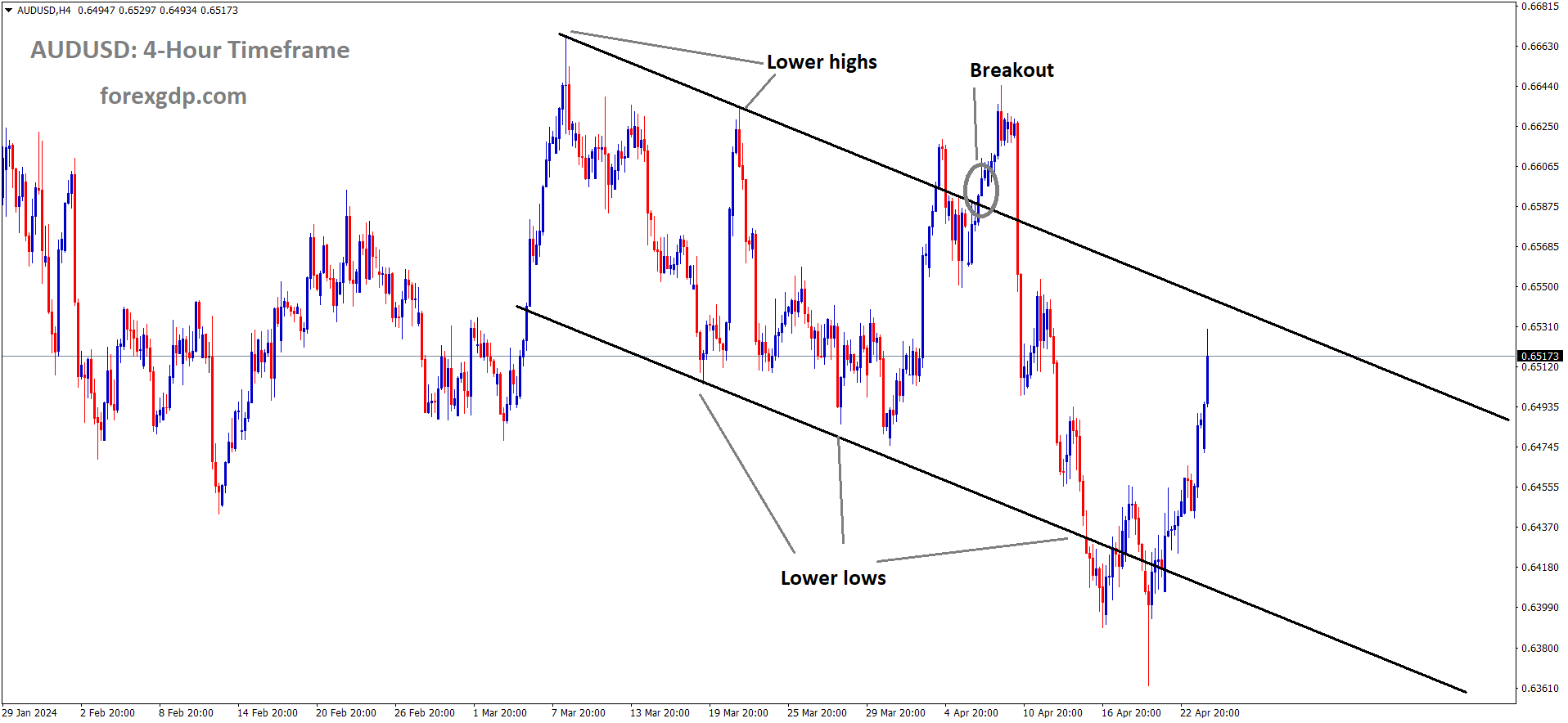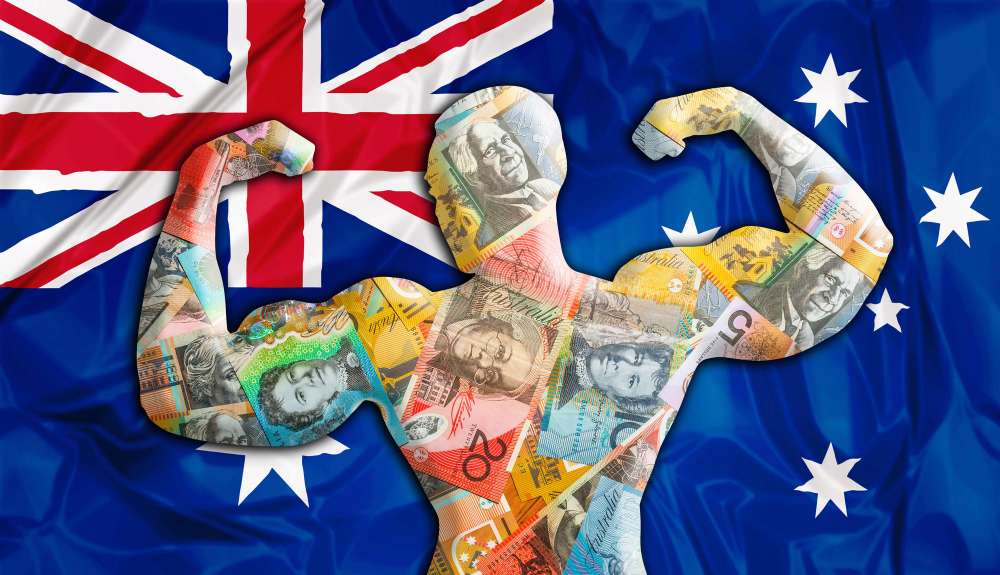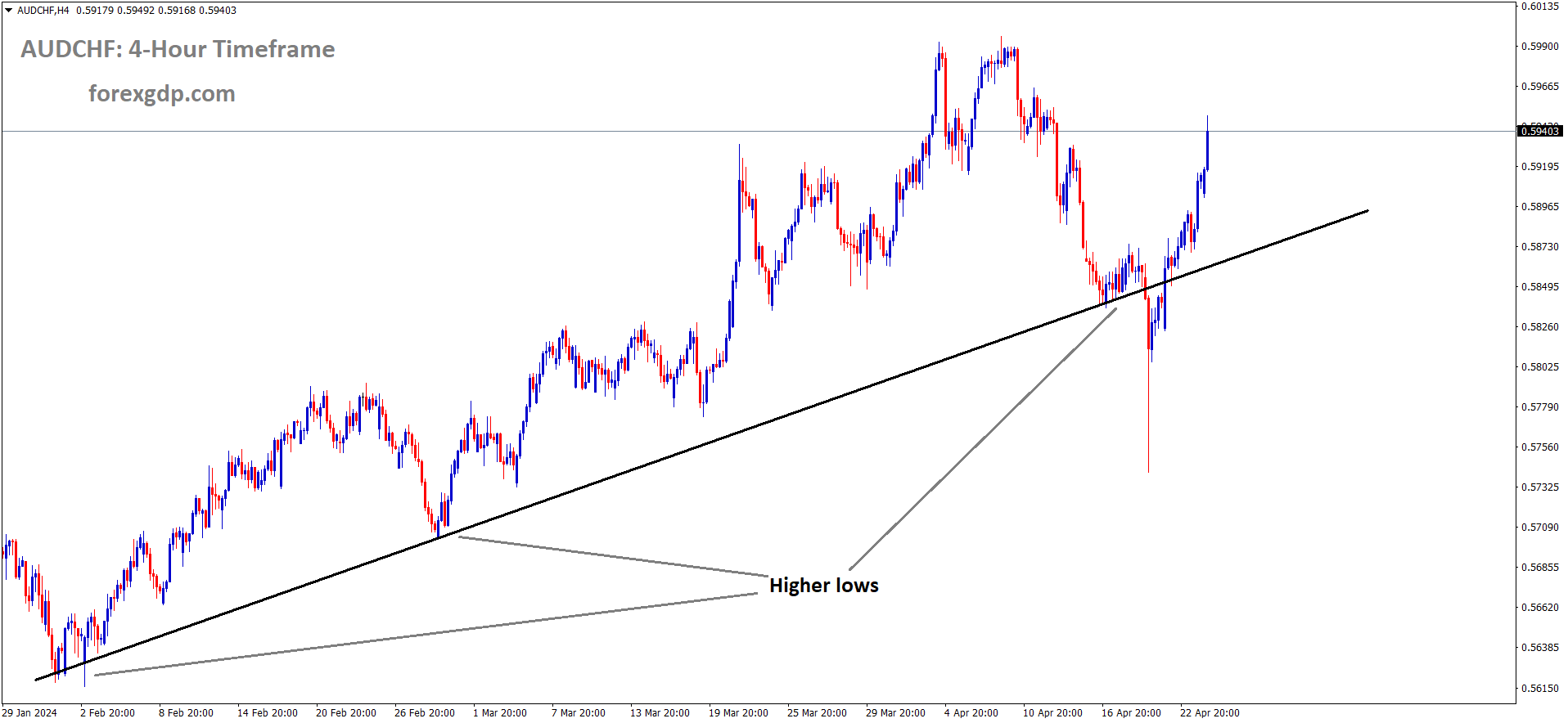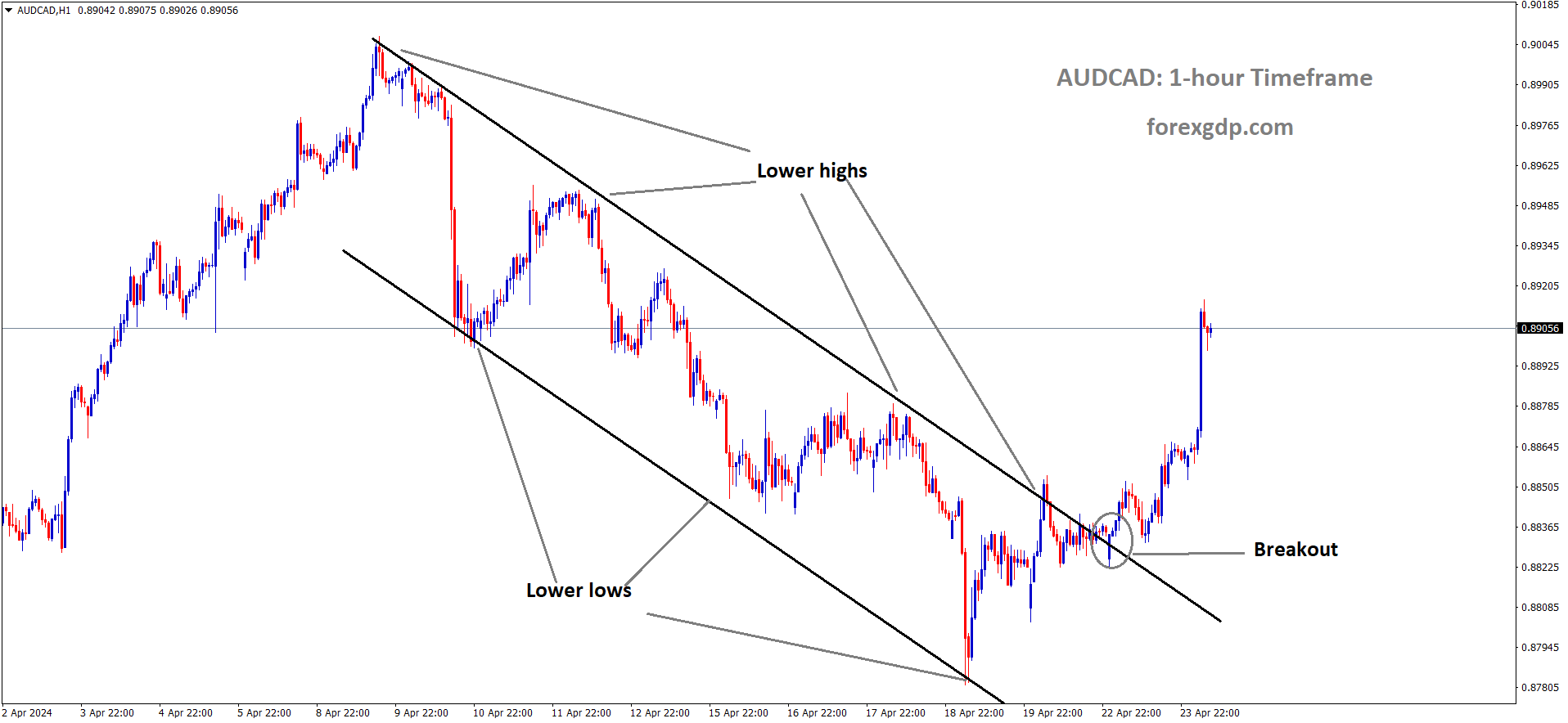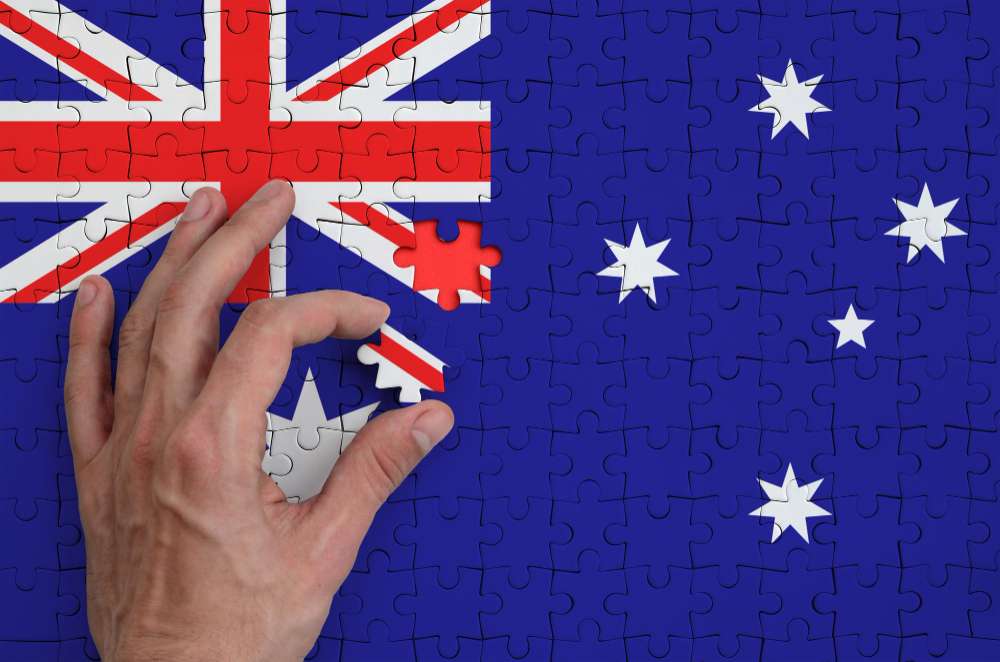AUD: AUD extends gains on strong CPI, weak USD
The Australian CPI Q1 (QoQ) came at 1.0% versus 0.80% expected and 0.60%printed in the Q4 2023. CPI (YoY) data came at 3.6% versus 3.4% expected and 4.1% printed in the previous quarter. Monthly CPI data came at 3.5% in the March month versus 3.4% printed in the previous month. Upbeat CPI Data makes Australian Dollar moved higher against counter pairs. This CPI Data favors for RBA to do hawkish tone in the upcoming months.
AUDUSD is moving in Descending channel and market has rebounded from the lower low area of the channel
The Australian Dollar (AUD) continues its upward trend, marking its third consecutive day of gains following the release of unexpectedly positive Consumer Price Index (CPI) data on Wednesday. The robust inflation figures are seen as potentially bolstering a more hawkish stance regarding the monetary policy outlook of the Reserve Bank of Australia (RBA), thereby strengthening the Australian Dollar (AUD) and supporting the AUD/USD pair.
Additionally, the Australian Dollar (AUD) is boosted by gains in the ASX 200 Index, particularly driven by the technology and healthcare sectors. This positive momentum in Australian stocks mirrors the upbeat sentiment on Wall Street, propelled by strong corporate earnings reports.
Conversely, the US Dollar Index (DXY), which measures the US Dollar (USD) against a basket of major currencies, faces downward pressure due to declining US Treasury yields and disappointing Purchasing Managers Index (PMI) data from the United States (US). These factors contribute to the weakness of the US Dollar (USD) and further support the AUD/USD pair. However, despite the sluggish PMI data, reports indicate continued expansion in US business activity in April, albeit at a slower pace compared to March.
In the market update, the Australian Dollar appreciates following the release of upbeat consumer inflation data. Australia’s CPI rose by 1.0% QoQ in the first quarter of 2024, surpassing expectations, while the YoY CPI increase stood at 3.6%. Meanwhile, the US PMI data shows a decline, with the preliminary S&P Global Composite PMI dropping to 50.9 in April and Manufacturing PMI falling to 49.9, indicating contraction. Australia’s own PMI figures show mixed results, with the Composite PMI reaching a 24-month high but Services PMI declining.
Furthermore, reports suggest that the People’s Bank of China (PBoC) plans to lower the Medium-term Lending Facility (MLF) rate, which could impact the Australian market due to the countries’ close trade ties. Additionally, the probability of the Federal Reserve keeping interest rates unchanged in the June meeting has increased to 84.6%, according to the CME FedWatch Tool.
AUD: CPI Up 1.0% in Q1 2024
The Australian CPI Q1 (QoQ) came at 1.0% versus 0.80% expected and 0.60%printed in the Q4 2023. CPI (YoY) data came at 3.6% versus 3.4% expected and 4.1% printed in the previous quarter. Monthly CPI data came at 3.5% in the March month versus 3.4% printed in the previous month. Upbeat CPI Data makes Australian Dollar moved higher against counter pairs. This CPI Data favors for RBA to do hawkish tone in the upcoming months.
AUDCHF is moving in Ascending trend line and market has rebounded from the higher low area of the pattern
In the March 2024 quarter, the Consumer Price Index (CPI) in Australia saw a 1.0% increase, according to the latest data from the Australian Bureau of Statistics (ABS). Annually, the CPI rose by 3.6%. Michelle Marquardt, head of prices statistics at ABS, noted that this quarterly increase surpassed the 0.6% rise seen in the previous quarter and contributed to an annual CPI inflation rate lower than the 4.1% recorded in the previous quarter, indicating a slight moderation from the peak of 7.8% observed in December 2022.
The significant contributors to the quarterly CPI rise included Education (+5.9%), Health (+2.8%), Housing (+0.7%), and Food and non-alcoholic beverages (+0.9%). Education fees surged, particularly in tertiary education, due to annual CPI indexation. Medical and hospital services prices rose, as did rents and prices for new dwellings purchased by owner-occupiers. Food and non-alcoholic beverage prices also increased, driven by non-alcoholic beverages, fruit and vegetables, and certain food products, though partially offset by decreases in meat and seafood prices.
On an annual basis, CPI rose by 3.6%, with Housing (+4.9%), Food and non-alcoholic beverages (+3.8%), and Alcohol and tobacco (+6.3%) contributing the most. The annual trimmed mean inflation, which reduces the impact of irregular or temporary price changes, was 4.0%, down from 4.2% in the previous quarter.
Additionally, the monthly CPI indicator, released by ABS, showed a 3.5% rise in the 12 months to March, compared to a 3.4% rise in the 12 months to February. Housing, food and non-alcoholic beverages, alcohol and tobacco, and insurance and financial services were significant contributors to this increase.
AUD: Australia’s Inflation at 3.6%, Dampens Rate Relief Hopes
The Australian CPI Q1 (QoQ) came at 1.0% versus 0.80% expected and 0.60%printed in the Q4 2023. CPI (YoY) data came at 3.6% versus 3.4% expected and 4.1% printed in the previous quarter. Monthly CPI data came at 3.5% in the March month versus 3.4% printed in the previous month. Upbeat CPI Data makes Australian Dollar moved higher against counter pairs. This CPI Data favors for RBA to do hawkish tone in the upcoming months.
AUDCAD has broken Descending channel in Upside
Australia’s inflation rate slowed less than anticipated in the March quarter due to increases in rents and education costs. This dimmed hopes that the cost-of-living pressure was easing and reduced the likelihood of official interest rate cuts in 2024.
According to the Australian Bureau of Statistics (ABS), the consumer price index (CPI) for the first quarter of 2024 was 3.6% higher than a year earlier, compared to the 4.1% annual pace in the previous quarter. Economists had expected CPI growth to drop to 3.5%. The March quarterly inflation rate stood at 1%, up from 0.6% in the December quarter, surpassing economists’ predictions of a rise to 0.8%.
Harry Murphy Cruise, an economist with Moody’s Analytics, remarked, “Having sprinted lower in the back end of 2023, headline inflation is struggling to keep that momentum going.” He attributed the slower progress to service inflation, anticipating a gradual easing of inflation in the future.
Education costs rose by 5.9% in the quarter, driven by a 6.5% increase in tertiary expenses, while health costs increased by 2.8%. Rents climbed by 2.1%, marking the fastest annual increase in 15 years, particularly driven by low vacancy rates. Electricity prices decreased by 1.7% in the March quarter, offsetting a rise of 1.4% in the previous three months. Without government rebates, the annual increase in electricity prices would have been significantly higher, at 17%.
The Reserve Bank of Australia’s (RBA) board will closely analyze the latest data during its upcoming meeting on 6-7 May. Prior to the data release, investors had discounted the possibility of an RBA rate cut next month, with markets fully pricing in a 25-basis point reduction in the cash rate by February 2025.
The federal budget, scheduled for release on 14 May, will also be influenced by the inflation figures. The government may argue that its spending plans won’t exacerbate inflation pressures, potentially delaying any interest rate cut by the central bank.
Following the ABS release, financial markets adjusted their expectations of an imminent interest rate cut. The Australian dollar appreciated, while the ASX200 share index retraced its gains for the day.
Apart from the headline CPI, the RBA also considers trimmed mean and weighted median measures, which both exceeded expectations for the quarter. While the trimmed mean eased to 4% annually, the weighted median remained steady at 4.4%.
Categories deemed “non-discretionary” rose by 4.2% annually, while “discretionary” ones rose by 2.9%. Notably, automotive fuel prices fell by 1% in the quarter, while food and non-alcoholic beverages were 3.8% higher than a year ago.
Overall, the data suggests a nuanced inflation landscape, impacting monetary policy decisions and broader economic strategies.
Don’t trade all the time, trade forex only at the confirmed trade setups
Get more confirmed trade signals at premium or supreme – Click here to get more signals , 2200%, 800% growth in Real Live USD trading account of our users – click here to see , or If you want to get FREE Trial signals, You can Join FREE Signals Now!


